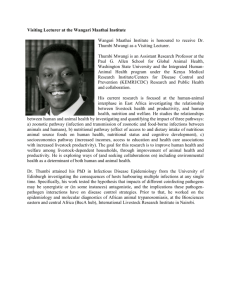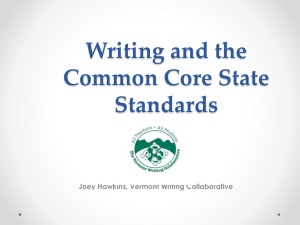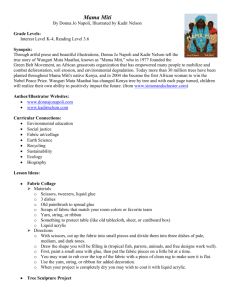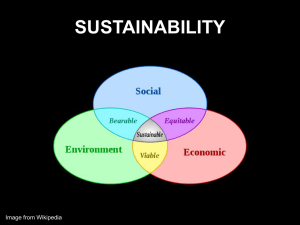Unbowed: A Memoir TEACHER`S GUIDE NOTE TO TEACHERS
advertisement
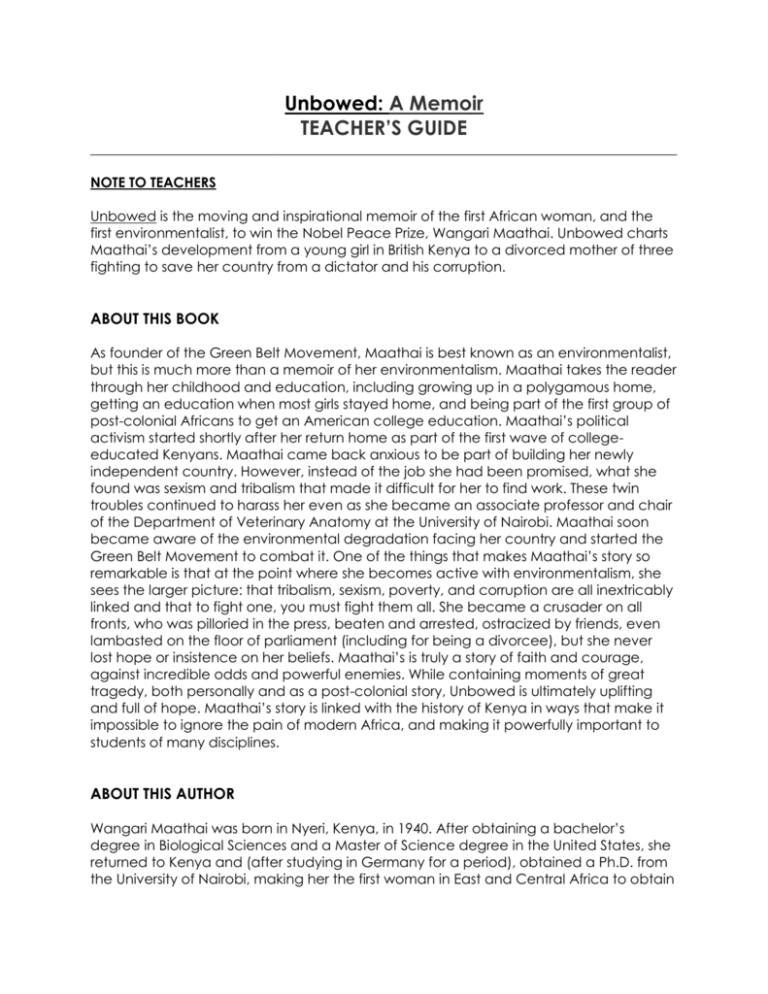
Unbowed: A Memoir TEACHER’S GUIDE _____________________________________________________________________________________ NOTE TO TEACHERS Unbowed is the moving and inspirational memoir of the first African woman, and the first environmentalist, to win the Nobel Peace Prize, Wangari Maathai. Unbowed charts Maathai’s development from a young girl in British Kenya to a divorced mother of three fighting to save her country from a dictator and his corruption. ABOUT THIS BOOK As founder of the Green Belt Movement, Maathai is best known as an environmentalist, but this is much more than a memoir of her environmentalism. Maathai takes the reader through her childhood and education, including growing up in a polygamous home, getting an education when most girls stayed home, and being part of the first group of post-colonial Africans to get an American college education. Maathai’s political activism started shortly after her return home as part of the first wave of collegeeducated Kenyans. Maathai came back anxious to be part of building her newly independent country. However, instead of the job she had been promised, what she found was sexism and tribalism that made it difficult for her to find work. These twin troubles continued to harass her even as she became an associate professor and chair of the Department of Veterinary Anatomy at the University of Nairobi. Maathai soon became aware of the environmental degradation facing her country and started the Green Belt Movement to combat it. One of the things that makes Maathai’s story so remarkable is that at the point where she becomes active with environmentalism, she sees the larger picture: that tribalism, sexism, poverty, and corruption are all inextricably linked and that to fight one, you must fight them all. She became a crusader on all fronts, who was pilloried in the press, beaten and arrested, ostracized by friends, even lambasted on the floor of parliament (including for being a divorcee), but she never lost hope or insistence on her beliefs. Maathai’s is truly a story of faith and courage, against incredible odds and powerful enemies. While containing moments of great tragedy, both personally and as a post-colonial story, Unbowed is ultimately uplifting and full of hope. Maathai’s story is linked with the history of Kenya in ways that make it impossible to ignore the pain of modern Africa, and making it powerfully important to students of many disciplines. ABOUT THIS AUTHOR Wangari Maathai was born in Nyeri, Kenya, in 1940. After obtaining a bachelor’s degree in Biological Sciences and a Master of Science degree in the United States, she returned to Kenya and (after studying in Germany for a period), obtained a Ph.D. from the University of Nairobi, making her the first woman in East and Central Africa to obtain a doctorate degree. She taught veterinary anatomy at the University of Nairobi, eventually becoming the chair of the Department of Veterinary Anatomy. In 1977, through her involvement in the National Council of Women (of which she was the chairperson from 1981—87), she created the Green Belt Movement, which has since planted over 40 million trees across Africa. She was elected as a member of parliament in 2002 and became the Assistant Minister for Environment and Natural Resources. In 2004 she became the first woman and first environmentalist to be awarded the Nobel Peace Prize, honored for her work on sustainable development, democracy and peace. She is the mother of three; she lives and works in Nairobi. TEACHING IDEAS The questions, exercises, and assignments that follow are intended to guide your students through Unbowed as a memoir, a work of history, political and environment science as well as women’s studies. The history of Kenya is interwoven with Maathai’s personal history, and an understanding of the colonial and post-colonial experiences in Kenya are crucial for a student’s appreciation of Unbowed. A careful reading, guided by the following questions, will provide the needed context. The following discussion points explore Kenya’s history and its importance to the story, test reading comprehension, offer issues for more in-depth discussion, and suggest additional memoirs, autobiographies, and works of African history. DISCUSSION AND WRITING Understanding Kenya and its role in the story The earliest known settlers to the region now known as Kenya came from northern Africa, in around 2000 BCE. Between around 500 BCE and 400 CE, Bantu-speaking peoples, who originated in what is now southeastern Nigeria, reached Kenya. The Bantu practiced slash-and-burn farming and also raised goats, sheep, and cattle. Over the following centuries, the small farming villages that the Bantu had established along the eastern coast of Africa developed into prosperous city-states, including Mombasa and Malindi in modern-day Kenya. By 1000 CE these city-states became part of a complex trading network linking Muslim Arab and Persian traders to the ports of East Africa, India, and China. As these traders settled in these East African city-states, Arabic blended with the Bantu language to form Swahili. In addition to trading goods, Muslim traders also introduced a small slave trade to East Africa, capturing around 1,000 slaves a year beginning in the ninth century CE and selling them to work for Muslim traders on the Arabian Peninsula and in Persia, India, and China. While Muslim traders dominated East African city-states for centuries, they would soon lose their dominance. Beginning in the fifteenth century, European nation-states began to develop advanced navigational technology. In 1497, the Portuguese explorer Vasco de Gama reached the East African coast and began to make claims to the city-states that had dotted the coast. These city-states soon became an important part of Portugal's trading empire in the Indian Ocean. Eventually other nations, including Great Britain, the Netherlands, and France, all gained footholds in the Indian Ocean trade. While Europeans were first interested in Africa primarily for trading reasons, by 1880 there was a scramble to establish colonies in Africa. From 1884 to 1885, fourteen European countries met at the Berlin Conference to create basic rules for how they were to divide Africa, and by 1914, only two countries, Liberia and Ethiopia, remained independent. During this time, both Great Britain and Germany took control of parts of modern-day Kenya, encompassing it in the colonies of British East Africa and German East Africa respectively. Independence was preceded by the Mau Mau revolution of 1952—56, which challenged British rule and heralded nearly a decade of a state of emergency. In 1963 Kenya gained its independence under the leadership of Jomo Kenyatta and his Kenya African National Union. In 1978 Daniel arap Moi became Kenya’s second president and shortly turned Kenya into a single-party state. Moi’s presidency was marked by corruption, rigged elections, and repression of dissidents. Multi-party elections were not allowed again until 1992 and Moi retained power until 2002 when the NARC (National Rainbow Coalition) opposition coalition elected a president and marked the return of democracy to Kenya. Also in 2002, Wangari Maathai was elected a member of Parliament. Additional sources on Kenyan history: http://crawfurd.dk/africa/kenya_timeline.htm www.kenyaweb.com/history/ www.infoplease.com/ipa/A0107678.html http://www.blissites.com/kenya/history.html Understanding the story and putting it in context Childhood 1.In the chapter “Beginnings,” Maathai tells the Kikuyu myth of origin. What is the significance of her inclusion of this story? What theme does she set up with the telling of this myth? 2.The beginning of the book includes many anecdotes illustrating the colonial relationship between the British and the Kenyans. For instance, the British renaming of everything they came upon created a “schism” in the minds of many Africans (p. 6). What does this tell us about the colonial relationship? Several times in the memoir Maathai will change her own name. What does each signify, emotionally and politically? 3.What does Maathai mean when she says “I was born as an old world was passing away” (p. 7)? 4.What was the relationship between religion and literacy in colonial Kenya? Pay attention to this topic, and see how it develops throughout Maathai’s life and career. 5.Who were the athomi? What role did they play in Kenyan history? 6.What does the reader learn about a polygamous household in Kikuyu society? What did Maathai think about the arrangement and what effect did it have on her, as a child and as an adult, especially in light of the fact that she became a champion of women’s rights? 7.How was Maathai’s relationship with her father? What do you find surprising about their relationship? Is it what you would expect from a polygamous family? 8.Why did Maathai, her mother, and sister move to Nyeri (p. 29)? What was unusual about their situation and what did this reveal about her family and their beliefs? 9.What was the effect of the British introduction of non-native trees to Kenya (p. 38)? Why did the Kenyans accept them? 10.In what ways is the fig tree of Maathai’s childhood a symbol (p. 44)? What does it represent to her? What does it tell us about the Kikuyu view and understanding of nature? Note other references to fig trees later in the book. 11.What role does storytelling play in the Kikuyu culture? What effect did it have on Maathai as a child? Education and Career 1.Why was Maathai’s family concerned about sending her to boarding school? Were their concerns valid? 2.As a young student what was Maathai’s attitude toward education? Compare and contrast her viewpoint with your own, or that of a “typical” American student. What hurdles did she face while trying to pursue an education? 3.What was Maathai’s relationship with whites during her childhood and adolescence? To what degree were her experiences positive or negative? Were there any that surprised you as a reader? 4.What was the basis of the Mau Mau uprising (p. 61)? Compare and contrast the Mau Mau to other guerrilla movements. What did the nuns at St. Cecelia’s do to help the British cause against the Mau Mau? What tangible effect did Kenya’s independence (and the battle for it) have on Maathai and her political beliefs? 5.What were Maathai’s experiences with and reactions to racism when she was in America? Does her reaction surprise you? What was her view of the civil rights movement? How does the racism of Maathai’s childhood differ with that of America during the same time? 6.How did her stay in Kansas change Maathai, physically, emotionally, and intellectually? 7.Why was Maathai not given the job at the zoology department upon graduation? What did that event indicate about Kenyan politics at the time? Relate her experience to the current political situation in other African nations. 8.What were some of the battles Maathai faced as a professor? How did she overcome these obstacles? What effect did she have on women who came after her? 9.Compare the sexism that Maathai experienced at work with that of American women of the same period. Would she have been able to advance to such a position of power as she did if she had been an American woman (either white or black) of the time? Kenyan politics 1.How does the first “greenbelt” Maathai planted in Kamakunji reflect colonialism’s impact on Kenya and its post-independence troubles? How is it representative of Kenya’s problems as a whole? 2.In what ways was the Green Belt Movement at its beginning also a women’s rights movement (see the chapter entitled “Foresters without Diplomas”)? Do you think the forestry officials that Maathai confronted were sexist? 3.In what ways did traditional Kenyan and British colonial cultural traditions clash in regard to Maathai’s engagement, marriage and divorce? 4.How and why did the NWCK lose most of its funding and become a second-tier organization? What does this show about Kenyan politics and how does it foreshadow the Moi presidency? 5.Why did men join the Green Belt Movement at the grassroots level? What were some of the results, both positive and negative? 6.How and why did Maathai’s involvement in the Green Belt Movement lead her into the pro-democracy movement? When did she first officially join the pro-democracy movement? What were the results? 7.How would you characterize the methods used by Maathai in fighting the development of Uhuru Park? What do you think of them? How else could she have approached this struggle? 8.What was the turning point in the battle to defeat the Times complex (the “park monster”) in Uhuru park? 9.How did Kenya move from a democracy to a totalitarian regime? 10.What precipitated Maathai’s barricading herself in her home? What was the result? 11.In the chapter “Aluta Continua,” police come to Maathai’s house while she is having an illegal meeting. How does Maathai react? How would you have reacted, given her history with the police? What did she mean when she wrote she disarmed the police “figuratively” (p. 232)? How do you think the police felt? 12.The “teach-ins” that Maathai and the Green Belt Movement held in the 1990s are reminiscent of the 1960s in America. What are other connections between 1990 Kenya and 1960 U.S.? 13.What was the connection between the tribal clashes of the early 1990s and the government’s anti-democracy repression? How do tribal clashes help the ruling party? (Can you find similar examples in other African countries?) What is the connection between the tribal clashes and environmental degradation? 14.How are the tribal clashes a legacy of colonial times? 15.How was female genital mutilation used to try to control Maathai? Discuss how FGM is always about controlling women. 16.In the Kenyan elections of 1992 and 1997, what problems with the politicians and electorate did Maathai identify? What did she want them to do? Compare Kenya to other emerging democracies in Africa or elsewhere. 17.How did ethnicity and tribalism affect Kenya’s multi-party elections and attempts to create a true democracy? 18.What is “land grabbing” and how did it affect Kenya’s democracy? What was Maathai’s involvement in the issue? What does the issue symbolize? 19.Explain Maathai’s “rise up and walk” political philosophy and explain how it differs from what the electorate wanted in previous elections. How is this philosophy related to her environmental activism? 20.When Maathai was awarded the Nobel Peace Prize, many wondered why an environmentalist would receive such an award. Explain why Maathai and her activism were worthy of the prize. What are her “three pillars”? In-Depth Discussion 1.Look back at the philosophical observations made by Maathai through the course of the memoir. For example, “We do the right thing not to please people but because it’s the only logically reasonable thing to do, as long as we are being honest with ourselves–even if we are the only ones left.” (p. 165) And, “[W]hile it’s perhaps sometimes foolhardy to take on something that’s too big for you, it is incredible what you can achieve if you are single-minded enough.” (p. 49) Choose one and explain how she lived it as a personal philosophy. 2.Maathai was a part of a number of moments of great historical significance (Kennedy Air Lift, Mau Mau, the global environmental and human rights movements, the women’s movement, etc.). Choose one to research and discuss how it affected her life and Kenyan politics and history. 3.Maathai’s ancestors did not see trees as timber; it was European culture that brought to Kenya the idea that nature could be a source of commerce. This cultural difference obviously had grave consequences for Kenya. What are other examples of differences or misunderstandings of culture that caused conflict? How does the idea of culture drive Maathai’s political actions? 4.Women are considered symbols of many different things in most cultures. Maathai first introduces this idea on p. 111 when she talks about women being “carriers and promoters of culture.” Track this idea through the memoir. Where does this idea cause conflict for Maathai and what does she do in response? How does the fight against this idea influence her path and politics? 5.Maathai wrote, “A great river always begins somewhere” (p. 119). She ended up becoming many things: an environmentalist, a women’s rights activist, a politician, and a dissident. Choose one and trace the origins of Maathai’s role by creating a timeline. 6.Discuss the ways that the Moi government used Maathai as a symbol and as a weapon in their effort to suppress all women. In what ways where they effective, or not? 7.When Maathai lost her job, it was international funding that allowed her to work for the Green Belt Movement as a full-time employee. Discuss the ways that the international community assisted Maathai throughout her life, both personally and professionally. 8.What do Maathai’s work and life story suggest about the role (and responsibility) of civil society organizations and individuals in bringing about social change on both small and large scales? 9.If you could interview Maathai, what would you ask her? Write ten questions and discuss them with a partner. Beyond the story 1.Why is debt such an important issue in African development? Put Maathai’s efforts to erase debt in context and prepare a report on the current state of the global movement to eradicate third-world debt. 2.Research the issue of tribalism and government complicity in ethnic clashes across Africa, or one particular country (other than Kenya). 3.Maathai was involved with many organizations considered part of the international women’s movement. Choose one dealing with women’s rights and create a profile of their current activities. 4.Choose another environmental movement or organization, either in the United States or abroad, and write an essay on it comparing and contrasting it to the Green Belt Movement. Further reading The Green Belt Movement: Sharing the Approach and the Experience, Wangari Maathai A New Name for Peace: International Environmentalism, Sustainable Development, and Democracy, Philip Shabecoff Flame Trees of Thika: Memories of an African Childhood, Elspeth Joscelin Huxley A Leaky Tent Is a Piece of Paradise, Bonnie Tsui, ed. Kenya: From Colonization to Independence, 1888—1970, R. Mugo Gatheru Facing Mount Kenya, Jomo Kenyatta Long Walk to Freedom, Nelson Mandela No Future Without Forgiveness, Desmond Tutu Wizard of the Crow and Petals of Blood, Ngugi wa’Thiongo A Continent for the Taking, Howard French Wonders of the African World, Henry Louis Gates, Jr. Imperial Reckoning, Caroline Elkins Iran Awakening, Shirin Ebadi [Winner of the 2003 Nobel Peace Prize] After the Guns Fall Silent, Jody Williams [Winner of the 1997 Nobel Peace Prize] Infidel, Ayaan Hirsi Ali An Inconvenient Truth, Albert Gore Courage for the Earth, Peter Matthiesen, ed. The Legacy of Luna, Julia Hill Animal, Vegetable, Mineral, Barbara Kingsolver About the Author of the Teacher’s Guide This guide was written by Stefanie Breitling. Ms. Breitling has a Master’s degree in Women’s Studies and one in English Education. She worked in book publishing for years, and is currently teaching English at a high school in The Bronx, New York.
